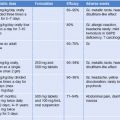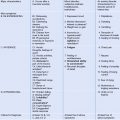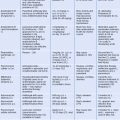CHAPTER 32 Hookworm Infection
Epidemiology
The transmission of human hookworm infection occurs in poor and rural areas of the developing world. Sub-Saharan Africa and Southeast Asia exhibit the highest prevalence (Table 32.1), although areas of high hookworm transmission also occur in tropical areas of the Americas (e.g. Central America, the Caribbean, and Brazil), India and Nepal, and South China.1 Hookworm is found predominantly in the rural areas of these regions because the infective larval stages that live in the soil depend on precise environmental conditions for their survival. Coastal areas are also notorious for endemic hookworm infection,2 probably because the sandy soils there facilitate the larval migrations required for transmission to humans.3 Finally, there is a very strong relationship between the prevalence of hookworm and poverty.1 Hookworm occurs almost exclusively among the poor, including the estimated 2.7 billion people who live on less than US $2 per day.4
Table 32.1 Global distribution (by World Bank region) and prevalence of hookworm infection
| World Bank region | Number of infections (millions) | Infection prevalence (%) |
|---|---|---|
| Latin America and the Caribbean | 50 | 10 |
| Sub-Saharan Africa | 198 | 29 |
| Middle East and North Africa | 10 | 3 |
| South Asia | 59 | 16 |
| India | 71 | 7 |
| East Asia and the Pacific Islands | 149 | 26 |
| Chinaa | 203 | 16 |
| Total | 740 | 15 |
a A new survey for intestinal parasites in China has been completed and there are indications that the prevalence of hookworm and other soil-transmitted helminths is lower than previous estimates might suggest.
Modified from de Silva et al.1
These demographic and epidemiologic features of hookworm infection are useful for assessing the risk of hookworm in immigrants. Hookworm would not be expected to be a significant health problem in immigrants from urban areas or among the middle and upper classes even if they are from developing countries. Instead, the immigrant patient populations at highest risk for hookworm infection are refugees from the poorest rural areas of Africa,5 Southeast Asia,6 South Asia, South China, and the Americas, especially Central America and Brazil.
Pathogenesis
Hookworm infection occurs when third-stage larvae penetrate the skin, usually through the hands and feet (especially between the toes). Repeated episodes of larval skin invasion result in a pruritic, papular rash known as ‘ground itch.’3 A. duodenale hookworm infection can also result from ingestion of the larvae. Subsequently, the larvae enter the venous circulation and reach the lungs within 10 days. Larval migration through the lungs can result in hookworm pneumonitis, which is characterized by a mild to moderate cough and sore throat. However, because it is associated with only recent infections, hookworm pneumonitis would not be expected to be common among refugees.
After leaving the lungs, hookworm larvae pass over the epiglottis and are swallowed. Within 5–9 weeks after initial infection the larvae molt twice to the adult stage. The appearance of adult hookworms in the intestine coincides with the onset of eosinophilia.7 Eosinophilia is a useful indicator for hookworm infection among refugees. For example, hookworm was detected in 55% of Southeast Asian refugees with persistent eosinophilia.6
Stay updated, free articles. Join our Telegram channel

Full access? Get Clinical Tree







